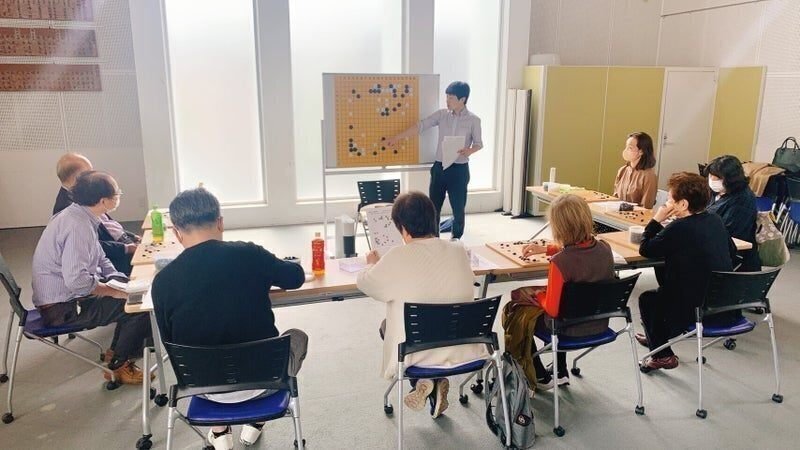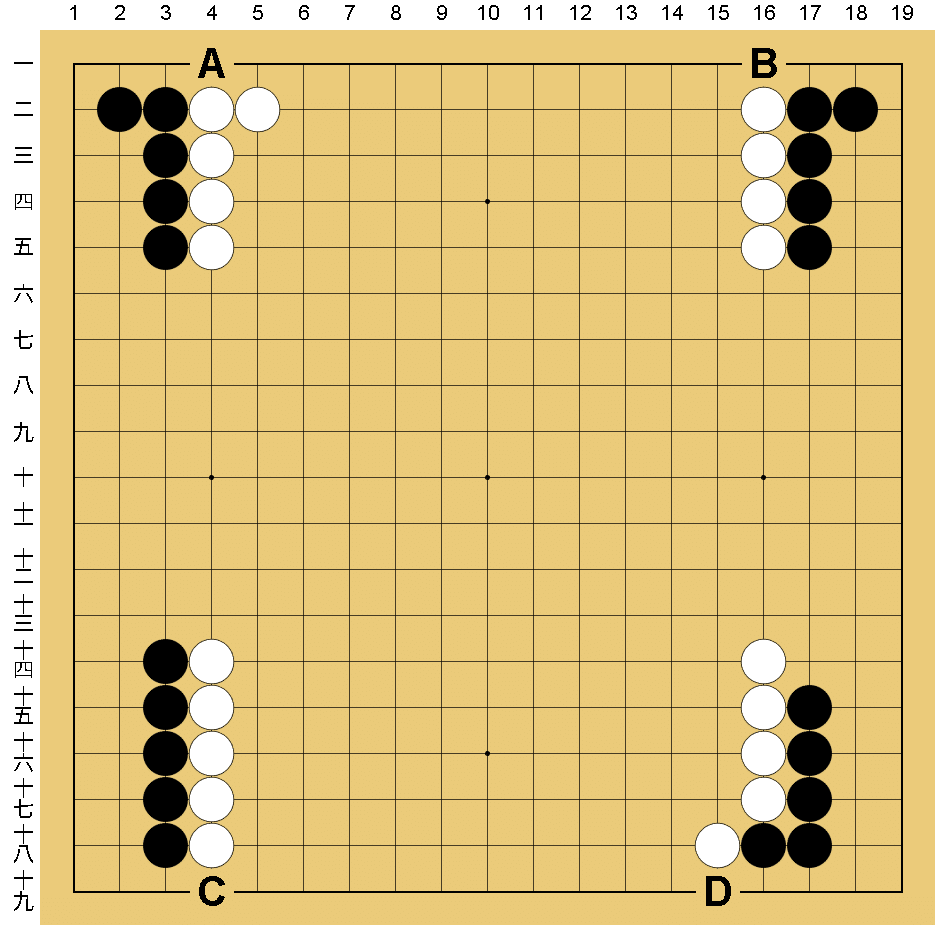
【GO】【English】 Basic "Yose" Moves. Do you know "Hanetsugi"?
※英語版の「ヨセ」の本を出版しました。このnoteは、そちらの内容を紹介する英語の記事になります。
Hello everyone.
My name is Tarou Usami.
I am a Go teacher in Tokyo, Japan(I worked at the Japan GO Association).
I published a book called "【GO】【English】 Basic "Yose" Moves. Do you know "Hanetsugi"?" on Amazon!
This is the English version of the book.
It is available for sale on this blog.
If you're interested, please give it a read!
About a third of the book is available to read for free.
A PDF data file will also be provided in the paid section.
Below is the content of the book.
【GO】 Basic "Yose" Moves Do you know "Hanetsugi"?
Hello everyone.
Thank you so much for picking up this book!!
This is my 11th published book.
It is also the second book I have published in English.
My name is Tarou Usami.
I am a Go teacher in Tokyo, Japan(I worked at the Japan GO Association).

I teach Go every day in my own classroom and online.

I wrote this book with the hope of teaching my students the basics of "Yose."
Do you know the word "Yose" in Go?
In Japan, the endgame of a Go game is called "Yose."
This book provides a detailed explanation of only the basic Yose technique, "Hanetsugi."
This movement is called "Hanetsugi."
Black 1 is "Hane" and Black 3 is "Tsugu".
This combination of movements is called "Hanetsugi."
By the way, White 2 is "Osae" and White 4 is "Tsugi".

By understanding "Hanetsugi", you will be able to understand "Yose".
Although there are some difficult parts to "Yose", I will try to explain it as gently and simply as possible.
I hope this book will help you understand "Yose."
Tarou Usami
【Theme of this book】
This book aims to help you understand the value of "Yose" from A to D in the diagram below.
Do you understand the value of black playing "hanetsugi" from A to D?

If you understand the meaning of "Hanetsugi" from A to D, there is no need to buy this book.
I am planning to publish another "Yose" book, so please be sure to buy it.
【Learn the value of "Hanetsugi" at the four corners!】
In the following diagram, which "hanetsugi" would you like to play, A to D?
Don't worry, I'll explain it in detail in Chapter 1 of this book.

If there were four places to place a "Hanetsugi" , A, B, C, and D, could you say, with reasons, which "Hanetsugi" you would place first?
Is that a 2-point "Hanetsugi"? Is it a 3-point "Hanetsugi"?
And is that "Hanetsugi" "Sente" or "Gote"?
"Sente" refers to the move that is your turn.
"Gote" refers to the move that is next to your opponent's turn.
I asked a lot of questions, but this is a Go question that even advanced players have difficulty answering.
So don't worry if you can't answer right now.
By reading this book, you should be able to understand the meaning of "Yose."
If you can fully understand the value of Yose and the concepts of Sente and Gote, you will be able to enjoy Go even more.
Let's study these two things thoroughly.
I have been a Go teacher for about 20 years, and many of my students say that "Yose" is difficult.
It is certainly difficult to play "Yose" perfectly, but Go does not require perfect play.
I hope that by reading this book you will be able to play a two-point "Yose" rather than a one-point "Yose."
I hope he improves at Go, even if it's just a little bit at a time.
Again, by learning the basic movement "Hanetsugi", you will be able to understand Yose more deeply.
【Table of contents of this book】
【GO】 Basic "Yose" Moves Do you know "Hanetsugi"?
【Theme of this book】
Chapter 1: The value of "Hanetsugi" at the four corners
Regarding the "Hanetsugi" from A to D in the first diagram.
About "Sente" and "Gote", which are important in "Yose".
Chapter 2: Basic knowledge of "Yose"
What is "Yose"? What is a point?
About the basic movement "Hanetsugi".
How to calculate "Yose".
Chapter 3: Application problems of "Yose"
Points to note about "Yose".
Supplementary information: "Ryosente" and "Gyakuyose"
Chapter 4: Various "Hanetsugi"
Introducing many "Hanetsugi"
【Finally】
【GO】 Basic "Yose" Moves Do you know "Hanetsugi"?
Chapter 1: The value of "Hanetsugi" at the four corners
You are black.
How much do you think the "hanetsugi" from A to D is worth?

The correct answer is,
A、2-point "Hanetsugi"
B、3-point "Hanetsugi"
C、4-point "Hanetsugi"
D、5-point "Hanetsugi"
I will explain in more detail.
A、"Gote"2-point "Hanetsugi"
B、"Sente"3-point "Hanetsugi"
C、"Sente"4-point "Hanetsugi"
D、"Sente"5-point "Hanetsugi"
I will now explain this answer.
【A diagram of the basic move "Hanetsugi" when playing as black.】
Each of the four corners is called a "Hanetsugi."

【About "Sente" and "Gote"】
About "Sente" and "Gote"
"Sente" is a move that makes you black again if you were black.
"Gote" is when you are playing black and it is your opponent's turn to play white.
In Go, "sente" is advantageous because you can play wherever you want.
【Let’s look at the answer again】
A、"Gote"2-point "Hanetsugi"
B、"Sente"3-point "Hanetsugi"
C、"Sente"4-point "Hanetsugi"
D、"Sente"5-point "Hanetsugi"

I think there are still many people who don't understand the meaning.
I will now explain each step in turn.
Chapter 2: Basic knowledge of "Yose"
【What is "Yose"?】
In Go, the move to bring each player's territory closer towards the end of the game is called "Yose."

For example, determining the boundary between A and B is also part of "Yose."
In Go, the opening game is called "Fuseki," the middle game is called "Tatakai," and the endgame is called "Yose."
Nowadays, with the development of AI, the game of Go has been studied quite a bit, but there are many changes in the early stages, and it is an area where humans cannot find the answer.
However, the endgame, or "Yose," is an area where the answer can easily be found through calculation.
Let's study "Yose" and try to get as much benefit as possible.
【The value (points) of "Yose"】
You can calculate the value (points) of a Yose with a simple calculation.
Let's use addition and subtraction to calculate the value (points) of "Yose."
【Example 1】
However, this does not need to be calculated.
How much is the Yose value (points) of a move by black playing A?

The correct answer is 1 point.
Do you understand one point?
The part marked with a square is worth 1 point.
If black plays, it will be white's turn.
So, "Gote" is 1 point.
【Even if White plays first, the value (points) of the "Yose" is the same.】
Even as a white player, A is worth "Gote" 1 point.

Let's move on to the next question.
【Example 2】
How much is the Yose value (points) of a move by black playing A?

This time the question has a white stone.
In this case, what is the value (points) of "Yose"?
This is "Gote"2 points.
The black player has captured a white stone.
So 1 + 1 = 2 points.
Whether you play black or white, you get two points.
And don't forget about "gote." "Sente" and "gote" are important in "yose."
【Example 2】
What is the value (points) of the "Yose" in this problem?
This time there are two white stones.

This is 4 points.
To be precise, it's "Gote"4 points.
The black player has captured two white stone.
So 2 + 2 = 4points.
In a similar problem, three white stones is worth six points, four white stones is worth eight points.
Are you beginning to understand the value (point) of "Yose" little by little?
【Basic movement "Hanetsugi"】
Now, let's start learning about the important topic of "Hanetsugi" in this book.

The right side is black and the left side is white, but the boundary has not yet been determined.
【If "Hanetsugi" is not used during this "Yose".】
The Go game ends with Black playing 1 and White playing 2.

So black has 31 points and white has 30 points, so black wins.
But let's try using "Hanetsugi" here. You'll see that it's a good deal.
Black 1 is "Hane", White 2 is "Osae", Black 3 is "Tsugimi", and White 4 is "Tsugimi". These moves are called "Hanetsugi".

Earlier, black had 31 points and white had 30 points.
However, if you use "hanetsugi", black still gets 31 points, but white gets 28 points.
You can see that "Hanetsugi" is more cost-effective.
【Let's do the calculations!】
In this example, how much do you think the value (points) of "Hanetsugi" is?
At first, black has 31 points and white has 30 points, and if you use "hanetsugi", black has 31 points and white has 28 points.
So is "Hanetsugi" worth 2 points?
Actually, that's not true. The value (points) of "Hanetsugi" is not 2 points.
We will explain how to calculate "Yose".
【How to calculate "Yose".】
In Go's "Yose" game, you need to think about both when you make a move and when your opponent makes a move.
This is when White plays "hanetsugi".
Earlier, black had 31 points and white had 29 points.
This is 29 points for black and 30 points for white.
This time white wins.
For white, the part marked with △ was helpful.

Black went from 31 points to 29 points, and white went from 28 points to 30 points.
When White plays "Hanetsugi", he can reduce the opponent's points by 2 points without reducing himself by 2 points.
So 2 + 2 = 4points.
And "Sente"4points.
The value (points) of this "Hanetsugi" is "Sente"4points.
【When Black plays "Hanetsugi"】
Black has 31 points, White has 28 points. Black wins by 3 points.

【When White plays "Hanetsugi"】
Black has 29 points, White has 30 points. White wins one point.

If black plays "hanetsugi", black wins by 3 points.
If White plays "Hanetsugi", White wins one point.
The difference is 4 points.
Hanetsugi" changes 4 points.
When Black plays "Hanetsugi".
Black has 31 points, White has 28 points. Black wins by 3 points.
When White plays "Hanetsugi".
Black has 29 points, White has 30 points. White wins one point.
This is how the value (points) of a Yose is calculated.
Add up the difference between when black plays first and when white plays first.
【The formula for calculating "Yose"】
"Increase or decrease in black" + "Increase or decrease in white" = "Yose" value (number of stitches)
Black went from 31 points to 29 points. The gain or loss is 2 points.
White went from 28 points to 30 points. The gain or loss is 2 points.
By adding these up, you can find the value (points) of the "Yose".
【Let's learn more about "sente" and "gote"】
ここから先は
サポートありがとうございます。コロナの影響もあり、今囲碁界はどんどん縮小していっています。どうにかしたいと思っている方は多いと思います。まずは小さな一歩から、囲碁の本を買ったり、近くの囲碁サロンに行ってみたり、周りに囲碁を教えてみて下さい。サポートは囲碁普及に使わせて頂きます。

